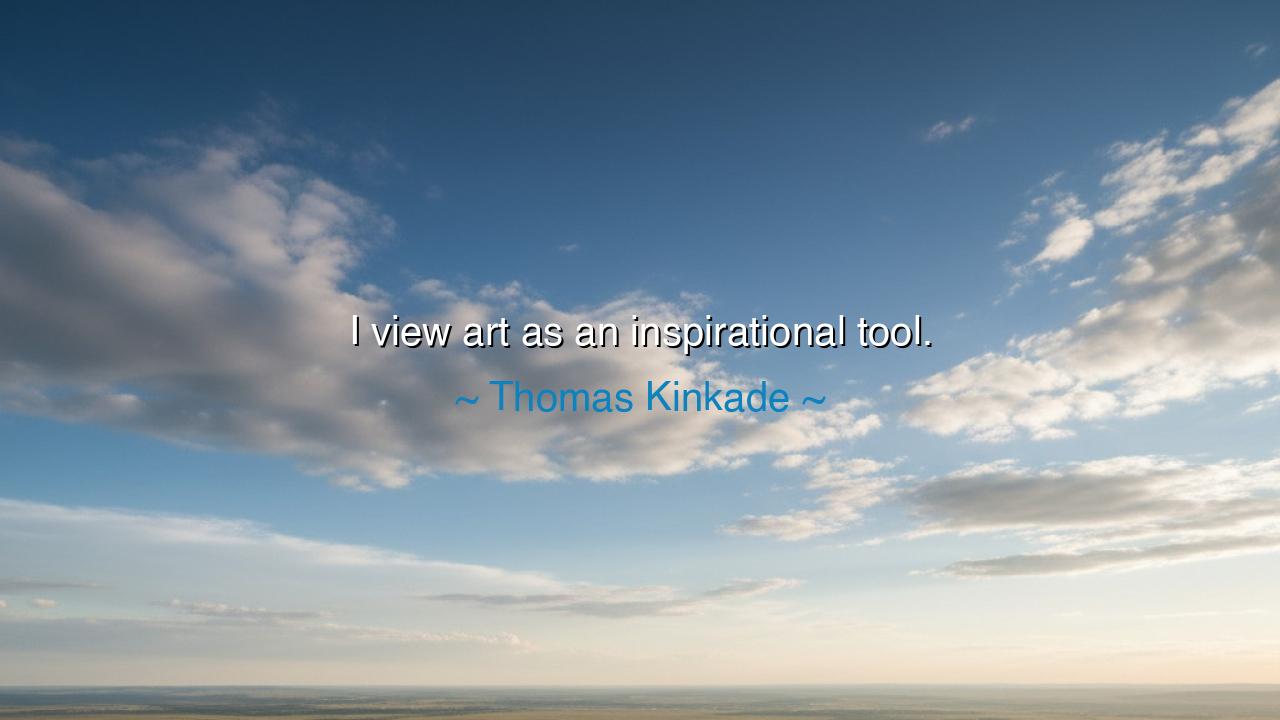
I view art as an inspirational tool.






In the words of Thomas Kinkade, the painter of light and serenity, we find a statement that glows with simple yet eternal truth: “I view art as an inspirational tool.” Though brief, this declaration carries within it the wisdom of centuries — for art has ever been more than decoration or delight; it has been the mirror of the soul, the voice of divinity, and the bridge between darkness and illumination. When Kinkade speaks of art as a tool, he does not diminish it, but honors its purpose — for tools are what humans use to build, to heal, to transform. His brush, therefore, was not only for painting scenes of beauty, but for inspiring hearts to see beauty in themselves and in the world around them.
To understand his words, we must first understand the man who spoke them. Thomas Kinkade lived in an age when the world was filled with turmoil, speed, and cynicism. Yet his paintings — glowing cottages, golden sunsets, peaceful streets — offered not escape, but remembrance. They reminded the weary soul that light still exists, that warmth and hope are not relics of the past but truths of the present. In calling art an inspirational tool, Kinkade confessed his mission: to use color and light as a means to heal, to uplift, and to reawaken the sacred within the ordinary.
The ancients, too, believed in this sacred function of art. The Greeks did not separate beauty from virtue; they saw both as paths to the divine. To them, a sculpture of Apollo or Athena was not mere stone — it was a conduit through which mortals could glimpse perfection. The Egyptians painted their tombs not to impress, but to prepare the soul for eternity. Even the medieval cathedrals, built centuries later, served the same purpose — every window, every carving, every burst of color was meant to inspire awe, to lift the spirit from earth to heaven. So it was in Kinkade’s philosophy: art must be more than seen — it must speak to the heart.
To call art a tool is to recognize its power to shape reality. A tool can build or destroy, depending on the hand that wields it. Kinkade chose to build — to craft not the images of despair, but of hope. In this, he followed the path of the great masters of spirit: Leonardo da Vinci, who saw art and science as a single language of creation; Michelangelo, who carved divinity from marble; and Rembrandt, who painted light itself as a metaphor for grace. Each understood, as Kinkade did, that art is a form of prayer — not a retreat from the world, but an offering to it.
Consider, too, the story of Florence Nightingale, who once wrote that “color and form can heal the sick.” When she designed hospitals, she chose soft hues and windows full of light — because she knew that beauty could restore the soul when medicine could not. Kinkade’s paintings, hanging in homes around the world, carried the same medicine. People who had lost faith would look upon his works and remember gentleness, peace, and the warmth of home. His art became not a possession, but a sanctuary, a tool for spiritual restoration.
Yet Kinkade’s vision was not without challenge. Many critics dismissed his work as sentimental, too soft for the modern age. But therein lies his courage — to paint hope in an age that glorified irony. True inspiration is not born from pleasing the intellect, but from touching the soul. And in this way, his art became a quiet rebellion — a stand against despair, a declaration that beauty still matters, that light, no matter how small, still has the power to pierce the shadows.
So, dear listener, let the lesson be this: view your own creations, whatever they may be, as tools of inspiration. Whether you paint, write, build, teach, or simply live with compassion, your actions can shape the hearts of others. Seek not only to create, but to elevate. Let your words heal, your work uplift, and your presence remind others of light. For as Thomas Kinkade teaches, art — in all its forms — is not a luxury, but a service to the spirit. And in a world so often dimmed by fear and doubt, to create something inspirational is not merely an act of beauty — it is an act of courage.
Therefore, paint your life with purpose. Let every gesture be a stroke of light upon the canvas of existence. For one heart moved by your creation is worth more than all the gold of empires — and that, in truth, is what it means to make art an inspirational tool.






AAdministratorAdministrator
Welcome, honored guests. Please leave a comment, we will respond soon